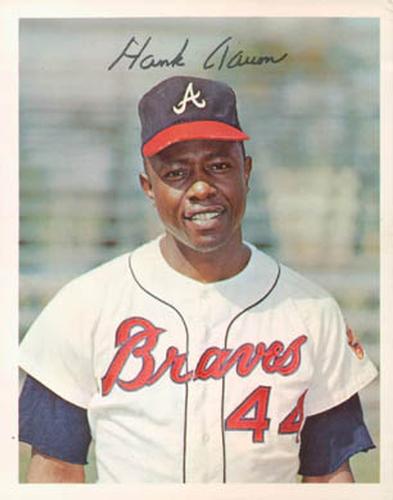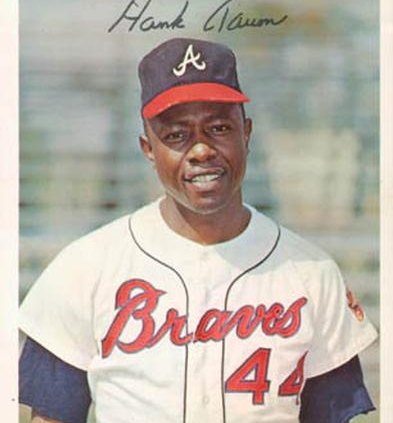May 10, 1967: Henry Aaron hits his only inside-the-park home run, but Braves lose on passed ball
 Of the 755 home runs that Henry Aaron hit from 1954 through 1976 with the Milwaukee and Atlanta Braves and Milwaukee Brewers, 754 cleared fences in 31 different big-league ballparks. Aaron’s only major-league inside-the-park home run came on May 10, 1967, in the first game of a doubleheader between the Braves and Philadelphia Phillies. It tied the score and cost fellow future Hall of Famer Jim Bunning a likely win at Philadelphia’s Connie Mack Stadium – but the Phillies eventually won the game when a missed connection between two more Cooperstown-bound Braves players resulted in a walk-off passed ball.
Of the 755 home runs that Henry Aaron hit from 1954 through 1976 with the Milwaukee and Atlanta Braves and Milwaukee Brewers, 754 cleared fences in 31 different big-league ballparks. Aaron’s only major-league inside-the-park home run came on May 10, 1967, in the first game of a doubleheader between the Braves and Philadelphia Phillies. It tied the score and cost fellow future Hall of Famer Jim Bunning a likely win at Philadelphia’s Connie Mack Stadium – but the Phillies eventually won the game when a missed connection between two more Cooperstown-bound Braves players resulted in a walk-off passed ball.
Barely a month into the 1967 season, both Atlanta and Philadelphia were stuck in a pack of teams in the 10-club National League, all chasing the first-place Cincinnati Reds. The Braves had won three of four in a series played on an April weekend in Atlanta.
A three-game weeknight set between the two clubs was scheduled for May 8-10 in Philadelphia. After the first game of the series was rained out, the Phillies won the next day, 3-2, and a twilight-night doubleheader was scheduled for May 10 to complete the series. Both teams had to hit the road after the series was completed.
Bunning started the opener for Philadelphia. The nine-time All-Star was a workhorse in 1966, leading the majors in games started (41, in which he pitched 314 innings). He also led all hurlers with five shutouts and notched exactly 19 victories for the fourth time in five years.1 Now 35 years old, Bunning was off to a slow start to 1967, winning only two of his first five decisions, and the right-hander entered this game with an ERA of 5.23. In the first game of an April 30 doubleheader in Atlanta, Bunning had taken a one-hit shutout into the sixth inning but squandered a 3-0 lead by allowing homers to Felipe Alou, Joe Torre, and Rico Carty in a five-batter span.2
For the visiting Braves, southpaw Dick Kelley had the mound duties. Over what turned out to be a seven-season big-league career, Kelley was primarily a reliever (he made 61 starts in 188 career appearances), but this was his fourth start of the young season.3 Against the Phillies on April 28, he had lasted a mere 1⅔ innings, yielding six earned runs.4 In his most recent outing, however, Kelley had pitched a three-hit shutout against the Chicago Cubs on May 3.
Bunning threw the first pitch for the first game at 6:06 P.M. The crowd at Connie Mack Stadium numbered 9,252.5
After the Braves went scoreless in the top of the first, the Phillies exploded in their turn at bat. Tony Taylor singled to center and took third on a double by Gary Sutherland. Dick Allen followed with another double, driving two runs home. Don Lock walked, and Cookie Rojas’s sacrifice moved both runners into scoring position.
Johnny Callison singled, and Allen scored. Lock advanced to third, but Callison was thrown out trying to advance to second on the play. Bobby Wine grounded to second for the final out, but Philadelphia had grabbed a three-run lead.
Kelley made it through the next two innings without allowing a hit. Jay Ritchie relieved him in the third and kept the Phillies hitless for two more innings. With Clay Carroll on the mound for Atlanta in the fifth, Taylor reached third base, but the Phillies could not capitalize, and Carroll added a one-two-three sixth.
Meanwhile, Bunning, seeking his 178th career win, was blanking the Braves on three scattered singles through six innings. As in his previous outing (April 30) against Atlanta, however, the Braves soon turned the game around with home runs.
Torre, Atlanta’s 26-year-old catcher, led off the top of the seventh by crashing “a moon shot to the left-center roof.”6 It was his fifth home run of the season. After Carty struck out, Mack Jones walked and Clete Boyer – who had gone 4-for-4 in the previous night’s game – singled. Gary Geiger pinch-hit for Woody Woodward and grounded a ball toward center field. But the ball never made it there. Second baseman Rojas dove to his right, scooping up the ball and flipping it to shortstop Wine, who stepped on second and threw to first, completing “the most spectacular double play of the season.”7
Carroll put up another clean inning in the seventh, and Mike de la Hoz pinch-hit for him in the eighth and singled to left. Bunning retired the next two Braves batters, but then Aaron belted a pitch to deep center. The ball sailed over center fielder Lock’s head and landed near the 420-foot mark. According to the Philadelphia Daily News, the ball was probably misplayed,8 and the Philadelphia Inquirer reported that Lock “failed to see it.”9 Given that the ball traveled more than 400 feet, there probably was not much of a chance Lock could make the play.
De la Hoz scored from first, and the 33-year-old Aaron just kept running. Lock retrieved the ball but threw over the head of his cutoff man, Wine. Rojas, backing up the play, caught the ball but then threw it over catcher Clay Dalrymple’s head. It was scored an inside-the-park home run. With the two runs, Atlanta had tied the game.
Atlanta manager Billy Hitchcock now called on Phil Niekro to pitch. The future Hall of Famer was in only his fourth season in the majors.10 He faced four batters in the bottom of the eighth. Taylor singled to center but was caught trying to steal second base. At the end of eight, the score was tied, 3-3.
Turk Farrell, a Phil from 1956 through 1961 and recently reacquired from the Houston Astros,11 came on to pitch the ninth for Philadelphia. The veteran right-hander had arrived at the ballpark less than an hour before the start of the doubleheader. Six days earlier, he was pitching for the Astros and had beaten the Phillies in relief. On this night, he faced the minimum, getting three quick outs.
With one out in the bottom of the ninth, Lock beat out an infield grounder to short for a single. Rojas followed with a grounder up the middle for a single, and Lock took third base. Then Niekro intentionally walked Callison, loading the bases. John Briggs was inserted as a pinch-hitter for Wine. Briggs never got to swing, as Niekro’s first pitch was wide of the plate and got by Torre. Lock “loped home with the winner,” as the Phillies claimed a 4-3 win.12
After the game, Torre, who was inducted into the Hall of Fame in 2014 as a manager, blamed himself for the loss. His “oversized catcher’s mitt zigged while a Phil Niekro knuckler zagged.”13 In the next day’s box score and recaps in both the Philadelphia and Atlanta newspapers, the official scorer called it a wild pitch, but Torre disagreed. “It broke [at] the last split-second,” he told reporters. “I had my glove up.”14 He then added, “It wasn’t a wild pitch. I should have caught it.”15 When the official scorer learned of Torre’s remarks, he changed the ruling to a passed ball.16
Torre and the Braves rebounded in the second game of the doubleheader. Torre hit two more homers, and Aaron added the 449th home run of his career in Atlanta’s 7-2 win. As Bill Conlin of the Philadelphia Daily News put it, the Phillies “split a doubleheader with Joe Torre and Hank Aaron.”17 Aaron feasted on Philadelphia pitchers in 1967, hitting a total of eight home runs and driving in 21 runs, his best effort against any team that year. He batted .353 and slugged .765 against the Phillies.
The two-homer doubleheader gave Aaron seven home runs in 1967. He had already led the National League in home runs three times (1957, 1963, and 1966). In each of those years, Hammerin’ Hank hit 44 homers, to match his jersey number. He went on to lead the NL in home runs in 1967 for the fourth and final time of his career, with 39. However, he did clobber 20 or more home runs in 20 consecutive seasons (1955-1974), when he hit his 715th homer to break Babe Ruth’s record for most career home runs.
Acknowledgments
This article was fact-checked by Bruce Slutsky and copy-edited by Len Levin.
Sources
In addition to the sources mentioned in the Notes, the author consulted Baseball-Reference.com, MLB.com, Retrosheet.org, and SABR.org.
https://www.baseball-reference.com/boxes/PHI/PHI196705101.shtml
https://www.retrosheet.org/boxesetc/1967/B05101PHI1967.htm
Notes
1 In 1967 Bunning again led all major-league pitchers in games started (40), shutouts (6), innings pitched (302⅓), and strikeouts (253). He was rewarded with a second-place finish in the NL Cy Young Award voting.
2 Bunning received a no-decision, as he pitched only six innings. The Phillies scored three two-out runs in the top of the ninth to turn a 4-3 deficit into a 6-4 win. See https://www.baseball-reference.com/boxes/ATL/ATL196704301.shtml.
3 It was as a reliever that Kelley made it into the record books, in another game against the Phillies. On September 8, 1967, after retiring Rojas on an infield popup, Kelley struck out six Phillies in succession –Wine, Rick Wise, Taylor, Briggs, Callison, and Tony Gonzalez. This tied the National League record for most consecutive strikeouts by a relief pitcher. As of the beginning of the 2023 season, Arizona’s Randy Johnson holds the NL record; he struck out seven consecutive batters on July 18, 2001. The major-league record was set on August 2, 2020, by Detroit’s Tyler Alexander, when the reliever struck out nine consecutive batters.
4 He received a no-decision in Atlanta’s 9-8 win.
5 This was the Phillies’ second largest crowd since Opening Day. Philadelphia was dead last in National League attendance in 1967 and 1968.
6 Bill Conlin, “Phillies Split with Torre, Aaron,” Philadelphia Daily News, May 11, 1967: 57.
7 Allen Lewis, “Phillies Win on Wild Pitch, Lose on Homers,” Philadelphia Inquirer, May 11, 1967: 40, 56.
8 Conlin.
9 Lewis.
10 Niekro had made only one start in his first three major-league seasons, pitching five innings against the San Francisco Giants on September 17, 1965. On June 13, 1967, just over a month after this game, Niekro started (against the Phillies) and pitched a 1-0 shutout. All but one of the rest of his appearances for the season were as the starting pitcher. He led the NL with a 1.87 ERA. He also led the senior circuit with 19 wild pitches.
11 Farrell was sold to the Phillies on May 8.
12 Wayne Minshew, “Aaron, Torre, Jones Help Braves to Split,” Atlanta Constitution, May 11, 1967: 39, 42.
13 Conlin.
14 Conlin.
15 Associated Press, “Official Scorer Rules Passed Ball Won for Phillies,” Shamokin (Pennsylvania) News-Dispatch, May 11, 1967: 15.
16 “Official Scorer Rules Passed Ball Won for Phillies.”
17 Conlin.
Additional Stats
Philadelphia Phillies 4
Atlanta Braves 3
Game 1, DH
Connie Mack Stadium
Philadelphia, PA
Box Score + PBP:
Corrections? Additions?
If you can help us improve this game story, contact us.


